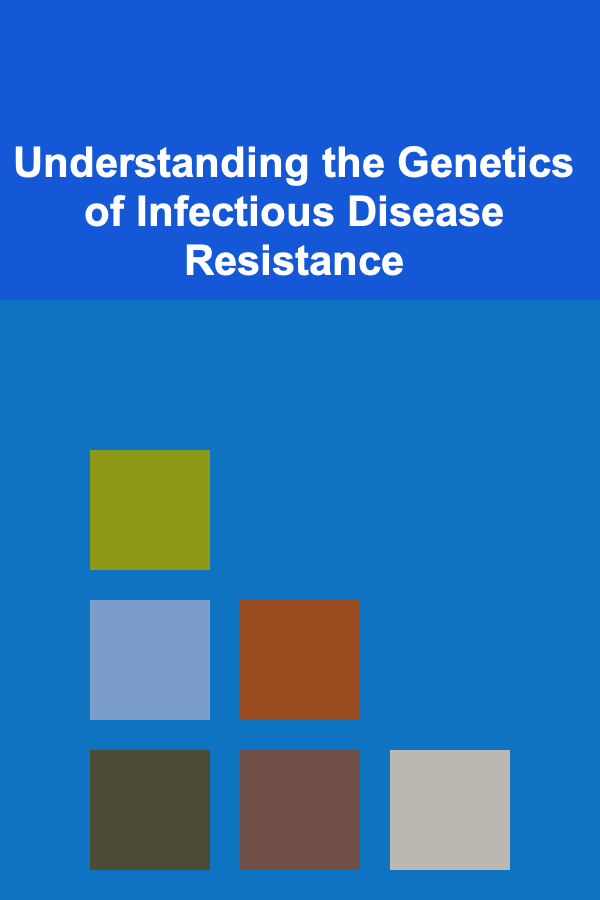
Understanding the Genetics of Infectious Disease Resistance
ebook include PDF & Audio bundle (Micro Guide)
$12.99$6.99
Limited Time Offer! Order within the next:

Infectious diseases have shaped human history, driving evolutionary pressures and causing widespread mortality. While hygiene, vaccination, and antimicrobial therapies have significantly reduced the burden of infectious diseases, understanding the genetic basis of resistance remains crucial for developing effective prevention and treatment strategies. This article provides a comprehensive overview of the genetics of infectious disease resistance, exploring various mechanisms, analytical approaches, and implications for public health.
The Interplay of Host, Pathogen, and Environment
Infectious disease susceptibility and resistance are determined by a complex interplay between the host, the pathogen, and the environment. The host's genetic makeup plays a significant role in determining its immune response, cellular defenses, and overall ability to combat infection. Pathogens, on the other hand, possess their own genetic determinants of virulence, transmissibility, and resistance to host defenses and antimicrobial drugs. Environmental factors, such as nutrition, hygiene, and exposure to other infections, can also modulate the host's susceptibility to disease.
Understanding these interactions is fundamental to comprehending the genetics of disease resistance. A purely genetic perspective that ignores environmental influences can be misleading, as even individuals with protective genetic variants may succumb to infection under specific circumstances. Conversely, individuals with genetic susceptibility may remain healthy if they are not exposed to the pathogen or benefit from protective environmental factors.
Mechanisms of Genetic Resistance
Genetic resistance to infectious diseases can manifest through various mechanisms, including:
1. Immune System Modulation
The immune system is the primary defense against infectious agents. Genetic variation in immune-related genes can significantly impact the efficacy of immune responses. This includes genes involved in:
- Antigen Presentation: Genes encoding major histocompatibility complex (MHC) molecules (also known as human leukocyte antigens or HLAs in humans) are highly polymorphic and play a crucial role in presenting pathogen-derived antigens to T cells. Different HLA alleles bind and present different antigens, leading to variations in T cell activation and immune response. For example, certain HLA alleles are associated with resistance to HIV-1 infection or delayed progression to AIDS.
- Cytokine Production: Cytokines are signaling molecules that regulate immune cell function. Genetic variants in cytokine genes (e.g., TNF-alpha, IL-10, IFN-gamma) can influence the intensity and type of immune response, affecting susceptibility to infection. For example, variations in the TNF-alpha gene promoter have been associated with susceptibility to tuberculosis.
- Innate Immunity: Innate immune receptors, such as Toll-like receptors (TLRs), recognize conserved pathogen-associated molecular patterns (PAMPs) and initiate inflammatory responses. Genetic variants in TLR genes can alter receptor signaling and affect the ability to detect and respond to pathogens. For example, certain TLR4 variants are associated with altered susceptibility to bacterial infections.
- Antibody Production: Genes involved in B cell development, antibody class switching, and antibody affinity maturation contribute to the humoral immune response. Variations in these genes can affect the ability to produce protective antibodies against specific pathogens. For example, variations in genes involved in antibody glycosylation can affect antibody effector functions.
2. Cellular Entry and Replication
Pathogens often require specific receptors or cellular pathways to enter and replicate within host cells. Genetic variations that disrupt these interactions can confer resistance to infection.
- Receptor Mutations: Mutations in host cell receptors that are required for pathogen entry can prevent or reduce infection. A classic example is the CCR5-Δ32 mutation, a 32-base pair deletion in the gene encoding the CCR5 chemokine receptor. Individuals homozygous for this mutation are highly resistant to HIV-1 infection, as CCR5 serves as the primary co-receptor for HIV-1 entry into CD4+ T cells.
- Intracellular Trafficking: Genetic variations in genes involved in intracellular trafficking pathways can affect the ability of pathogens to reach their replication sites within host cells. For example, variations in genes involved in autophagy can affect the ability to clear intracellular pathogens.
- Viral Restriction Factors: Certain host proteins act as viral restriction factors, directly inhibiting viral replication. Genetic variations in these genes can enhance their antiviral activity. Examples include APOBEC3G, which inhibits retroviral replication by inducing mutations in viral DNA, and TRIM5α, which binds to viral capsids and promotes their degradation.
3. Physiological Barriers
Physical and physiological barriers provide the first line of defense against infection. Genetic variations affecting the integrity or function of these barriers can influence susceptibility to disease.
- Epithelial Integrity: Genes involved in maintaining the integrity of epithelial barriers (e.g., tight junctions, mucus production) can influence the ability of pathogens to penetrate the host. For example, variations in genes encoding mucins can affect mucus viscosity and the ability to trap and clear pathogens from the respiratory tract.
- Antimicrobial Peptides: Antimicrobial peptides (AMPs) are small peptides with broad-spectrum antimicrobial activity. Genetic variations in AMP genes can affect their expression or activity, influencing the ability to kill pathogens. Examples include defensins and cathelicidins.
- Complement System: The complement system is a crucial part of the innate immune system that enhances the ability of antibodies and phagocytic cells to clear microbes and damaged cells. Genetic variations in complement components or regulatory proteins can alter the activity of the complement cascade, affecting susceptibility to infection. For instance, deficiencies in certain complement components increase the risk of bacterial infections.
4. Metabolic and Nutritional Factors
Host metabolism and nutritional status can influence susceptibility to infection. Genetic variations affecting metabolic pathways or nutrient utilization can impact the ability of pathogens to thrive within the host.
- Iron Metabolism: Iron is essential for both host and pathogen survival. Genetic variations affecting iron metabolism (e.g., hemochromatosis) can influence the availability of iron to pathogens, affecting their growth and virulence.
- Glucose Metabolism: Glucose is a primary energy source for pathogens. Genetic variations affecting glucose metabolism can impact the ability of pathogens to utilize glucose for replication. For example, individuals with certain genetic predispositions to diabetes may be more susceptible to certain infections.
- Vitamin D Metabolism: Vitamin D plays a role in immune regulation and antimicrobial defense. Genetic variations affecting vitamin D metabolism can influence susceptibility to infections, particularly respiratory infections.
5. Genetic Polymorphisms and Evolutionary Adaptation
The prevalence of certain disease-resistance genes in specific populations often reflects historical exposure to infectious diseases. These genetic polymorphisms represent evolutionary adaptations to selective pressures imposed by pathogens.
- Sickle Cell Trait and Malaria: The sickle cell trait (HbAS), caused by a mutation in the beta-globin gene, provides protection against severe malaria. Individuals heterozygous for the sickle cell allele (HbAS) have red blood cells that are less hospitable to the malaria parasite, Plasmodium falciparum. The high prevalence of the sickle cell trait in malaria-endemic regions is a classic example of balancing selection, where the heterozygous advantage (protection against malaria) outweighs the homozygous disadvantage (sickle cell disease).
- Duffy Antigen and Vivax Malaria: The Duffy antigen, a receptor for the chemokine CCL1, is also used by Plasmodium vivax to enter red blood cells. Individuals who lack the Duffy antigen (Duffy-negative) are resistant to P. vivax malaria. The Duffy-negative phenotype is common in sub-Saharan Africa, where P. vivax malaria is rare.
- Lactose Tolerance and Tuberculosis: Some studies suggest a correlation between lactose tolerance (persistence of lactase enzyme activity into adulthood) and increased susceptibility to tuberculosis. This seemingly paradoxical relationship might be due to the altered immune response associated with specific gut microbiome composition influenced by lactose digestion. This is still under research, and the connection is not fully elucidated.
Analytical Approaches to Identify Resistance Genes
Identifying the genetic basis of infectious disease resistance requires a combination of epidemiological, genetic, and immunological approaches. Some common methods include:
1. Genome-Wide Association Studies (GWAS)
GWAS involve scanning the entire genome for common genetic variants (single nucleotide polymorphisms or SNPs) that are associated with disease susceptibility or resistance. Large cohorts of individuals, both infected and uninfected, are genotyped, and statistical analyses are performed to identify SNPs that are significantly correlated with disease status. GWAS have been successful in identifying novel genes involved in susceptibility to various infectious diseases, including tuberculosis, hepatitis B, and HIV-1.
Advantages of GWAS:
- Unbiased approach: No prior knowledge of candidate genes is required.
- Genome-wide coverage: Can identify novel genetic variants across the entire genome.
- High throughput: Can analyze hundreds of thousands of SNPs in large cohorts.
Limitations of GWAS:
- Requires large sample sizes: Statistical power is often limited by the number of individuals included in the study.
- Primarily identifies common variants: Rare variants with large effects may be missed.
- Association does not equal causation: Identified SNPs may be in linkage disequilibrium with the causal variant.
- Difficult to identify gene-environment interactions: Requires specialized analysis.
2. Candidate Gene Studies
Candidate gene studies focus on examining specific genes that are hypothesized to be involved in disease resistance based on prior knowledge of their function or involvement in immune responses. These studies typically involve genotyping individuals for specific variants in candidate genes and assessing their association with disease susceptibility or resistance. Candidate gene studies are often used to follow up on findings from GWAS or to investigate genes identified in other studies.
Advantages of Candidate Gene Studies:
- Targeted approach: Can focus on specific genes of interest.
- Higher statistical power: Requires smaller sample sizes compared to GWAS.
- Can investigate rare variants: May be more sensitive to detecting rare variants with large effects.
Limitations of Candidate Gene Studies:
- Biased approach: Relies on prior knowledge of candidate genes.
- May miss novel genes: Only examines a limited number of genes.
- Difficult to validate findings: Positive associations may be due to chance.
3. Linkage Studies
Linkage studies are used to identify chromosomal regions that are linked to disease susceptibility. These studies are typically performed in families with a high prevalence of a particular disease. By analyzing the co-inheritance of genetic markers and disease status within families, researchers can identify regions of the genome that are likely to contain disease-susceptibility genes. Linkage studies are particularly useful for identifying genes involved in rare, Mendelian disorders of immunity.
Advantages of Linkage Studies:
- Powerful for identifying genes involved in rare, Mendelian disorders.
- Can map disease-susceptibility genes to specific chromosomal regions.
Limitations of Linkage Studies:
- Requires large pedigrees with a high prevalence of disease.
- Low resolution: Identified regions may contain many genes.
- Difficult to apply to common, complex diseases.
4. Expression Quantitative Trait Loci (eQTL) Mapping
eQTL mapping identifies genetic variants that influence gene expression levels. By correlating gene expression data with genotype data, researchers can identify eQTLs that regulate the expression of genes involved in immune responses or cellular defenses. eQTL mapping can provide insights into the mechanisms by which genetic variants influence disease susceptibility.
Advantages of eQTL Mapping:
- Provides insights into gene regulatory mechanisms.
- Can identify variants that influence gene expression levels.
- Can be used to prioritize candidate genes for functional studies.
Limitations of eQTL Mapping:
- Requires gene expression data, which can be challenging to obtain.
- Correlation does not equal causation: eQTLs may not directly regulate gene expression.
- Context-dependent: eQTLs may vary depending on the cell type or tissue.
5. Functional Genomics
Functional genomics approaches are used to investigate the functional consequences of genetic variants on cellular processes and immune responses. These approaches can include:
- In vitro cell culture studies: Cells are transfected with different genetic variants and their effects on cell signaling, cytokine production, and pathogen replication are assessed.
- Animal models: Animal models are used to study the effects of genetic variants on disease susceptibility and immune responses in vivo.
- CRISPR-Cas9 gene editing: CRISPR-Cas9 technology is used to edit specific genes in cells or animals to study their function in disease resistance.
- Proteomics and metabolomics: These approaches are used to identify changes in protein expression and metabolite levels in response to infection in individuals with different genetic variants.
Advantages of Functional Genomics:
- Provides direct evidence for the functional consequences of genetic variants.
- Can elucidate the mechanisms by which genetic variants influence disease susceptibility.
- Can be used to validate findings from GWAS and candidate gene studies.
Limitations of Functional Genomics:
- Can be time-consuming and expensive.
- In vitro and animal models may not accurately reflect human biology.
- Difficult to study complex genetic interactions.
Challenges and Future Directions
Despite significant progress in understanding the genetics of infectious disease resistance, several challenges remain.
1. Complexity of Genetic Architecture
Many infectious diseases are influenced by multiple genes, each with a small effect. Identifying these genes and understanding their interactions can be challenging.
2. Gene-Environment Interactions
The effects of genetic variants on disease susceptibility can be modified by environmental factors. Understanding these gene-environment interactions is crucial for developing effective prevention strategies.
3. Rare Variants
Rare genetic variants with large effects can contribute significantly to disease susceptibility, but are difficult to identify using traditional GWAS approaches. Whole-exome sequencing and whole-genome sequencing are increasingly being used to identify these rare variants.
4. Population Stratification
Differences in allele frequencies between populations can confound GWAS results. Careful attention must be paid to controlling for population stratification in these studies.
5. Translation to Public Health
Translating genetic findings into practical public health interventions can be challenging. Further research is needed to develop personalized prevention and treatment strategies based on an individual's genetic risk profile.
Future directions in this field include:
- Increased sample sizes in GWAS: Larger sample sizes will increase statistical power to detect genes with small effects.
- Integration of multi-omics data: Combining genomic, transcriptomic, proteomic, and metabolomic data will provide a more comprehensive understanding of the molecular mechanisms underlying disease resistance.
- Development of improved analytical methods: New statistical methods are needed to analyze complex genetic interactions and gene-environment interactions.
- Application of genome editing technologies: CRISPR-Cas9 technology can be used to create targeted gene edits in cells and animals to study the function of specific genes in disease resistance.
- Development of personalized prevention and treatment strategies: Genetic information can be used to identify individuals at high risk for infection and to tailor prevention and treatment strategies to their individual needs. This includes the development of personalized vaccines and therapies that target specific genetic vulnerabilities.
- Increased focus on the microbiome: The human microbiome plays a critical role in immunity and disease susceptibility. Future research should focus on understanding the interactions between host genetics, the microbiome, and infectious diseases.
- Development of rapid diagnostic tools: Genetic markers can be used to develop rapid diagnostic tools that can identify individuals who are resistant or susceptible to specific infections. This can help to improve patient care and prevent the spread of disease.
Conclusion
Understanding the genetics of infectious disease resistance is essential for developing effective strategies to prevent and treat infectious diseases. By identifying the genes that influence susceptibility and resistance, we can develop personalized prevention and treatment strategies that are tailored to an individual's genetic risk profile. Further research is needed to overcome the challenges associated with identifying and characterizing disease-resistance genes and to translate these findings into practical public health interventions. The continued investigation of host-pathogen interactions and the genetic factors involved will pave the way for more effective control and eradication of infectious diseases, ultimately contributing to improved global health.
Reading More From Our Other Websites
- [Small Business 101] Top Office Equipment for Small Business Success and Productivity
- [Home Holiday Decoration 101] How to Incorporate Traditional Holiday Colors into Your Home Decor
- [Personal Care Tips 101] How to Incorporate Hair Serum into Your Daily Hair Care Routine
- [Organization Tip 101] How to Organize Baby Photos into a Cherished Keepsake
- [Home Pet Care 101] The A to Z of Pet Obesity and How to Prevent It
- [Organization Tip 101] How to Organize Your Study Room for Different Learning Styles
- [Personal Care Tips 101] How to Use a Razor for a Quick and Efficient Morning Routine
- [Horseback Riding Tip 101] Top & Risks Covered by Horse Riding Insurance Policies
- [Scrapbooking Tip 101] From Pages to Memories: Mastering the Art of Journaling in Scrapbooks
- [Home Budget 101] How to Set Up an Emergency Fund for Homeowners on a Budget

How to Create a Checklist for Writing a Resume for Entry-Level Jobs
Read More
How to Create a Home Library with Smart Storage Solutions
Read More
How to Develop a Workout Routine for Desk Workers
Read More
How to Advocate for Environmental Justice
Read More
How to Manage Volleyball Player Burnout
Read More
How to Plan a Pilates Routine for Postpartum Recovery
Read MoreOther Products

How to Create a Checklist for Writing a Resume for Entry-Level Jobs
Read More
How to Create a Home Library with Smart Storage Solutions
Read More
How to Develop a Workout Routine for Desk Workers
Read More
How to Advocate for Environmental Justice
Read More
How to Manage Volleyball Player Burnout
Read More